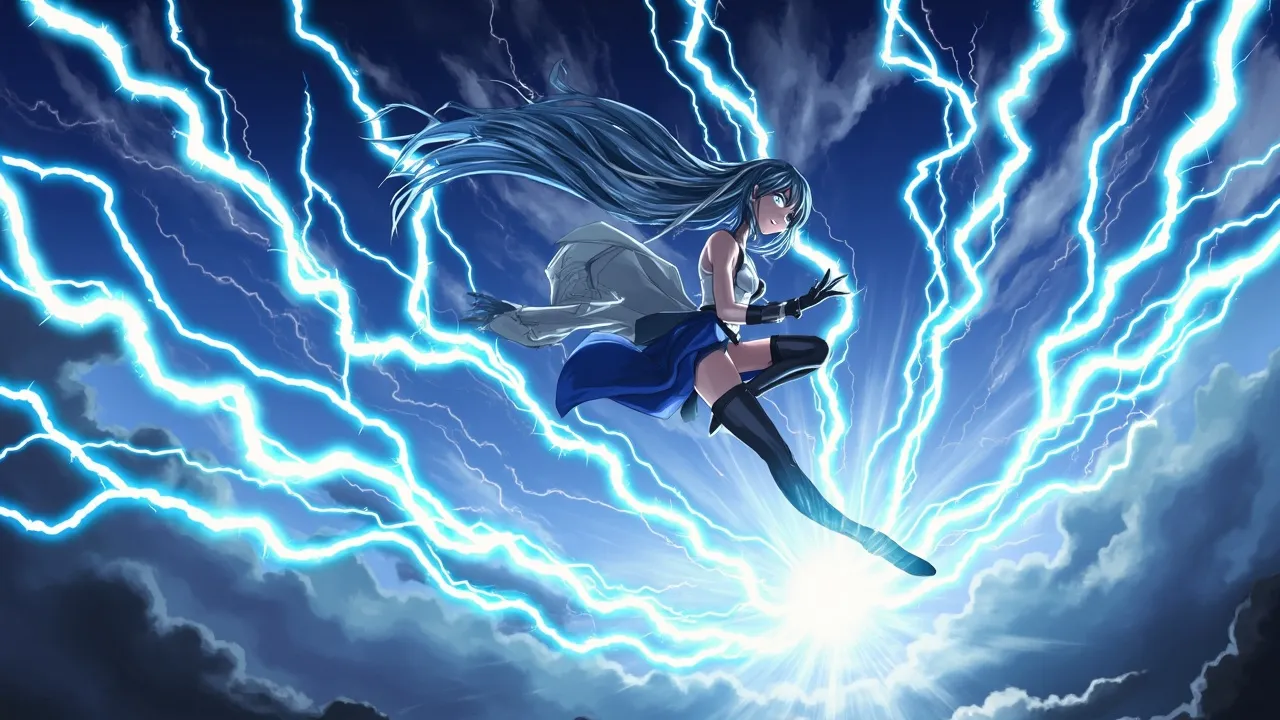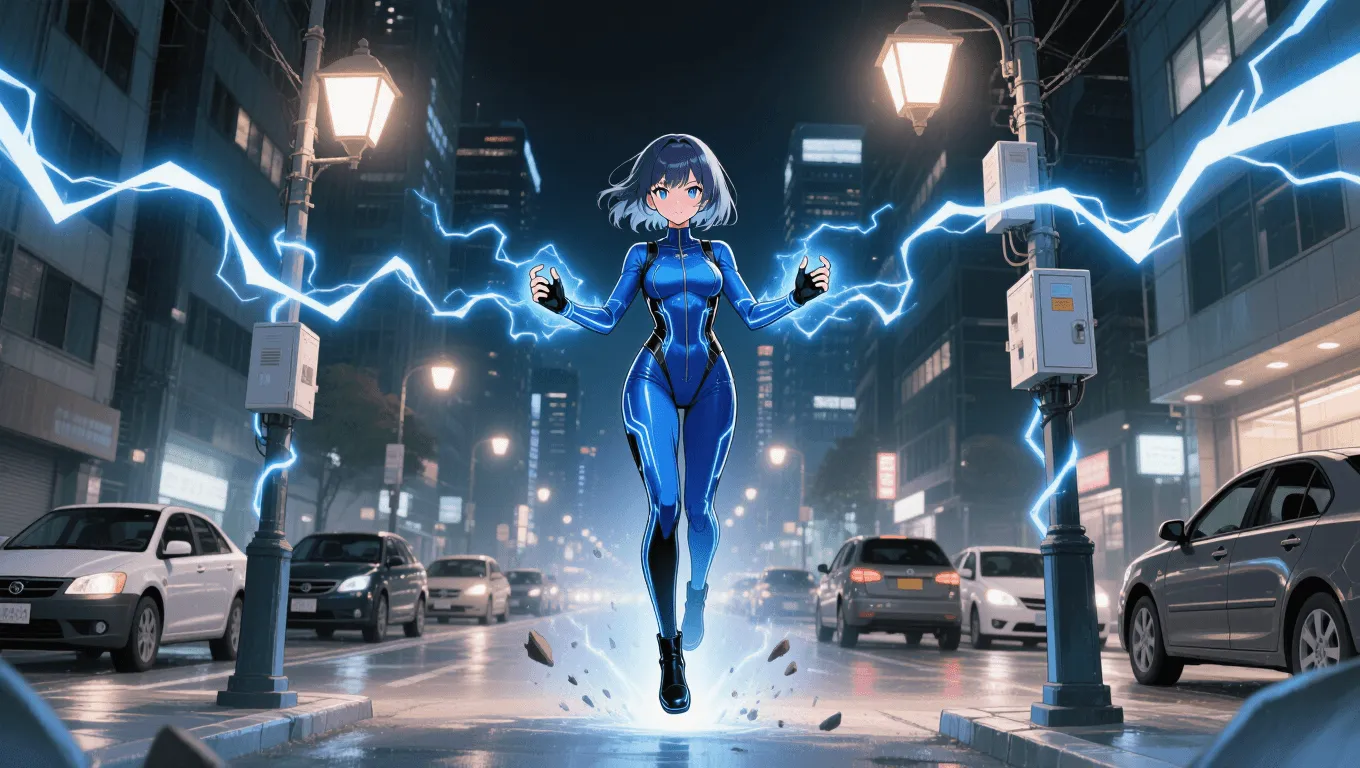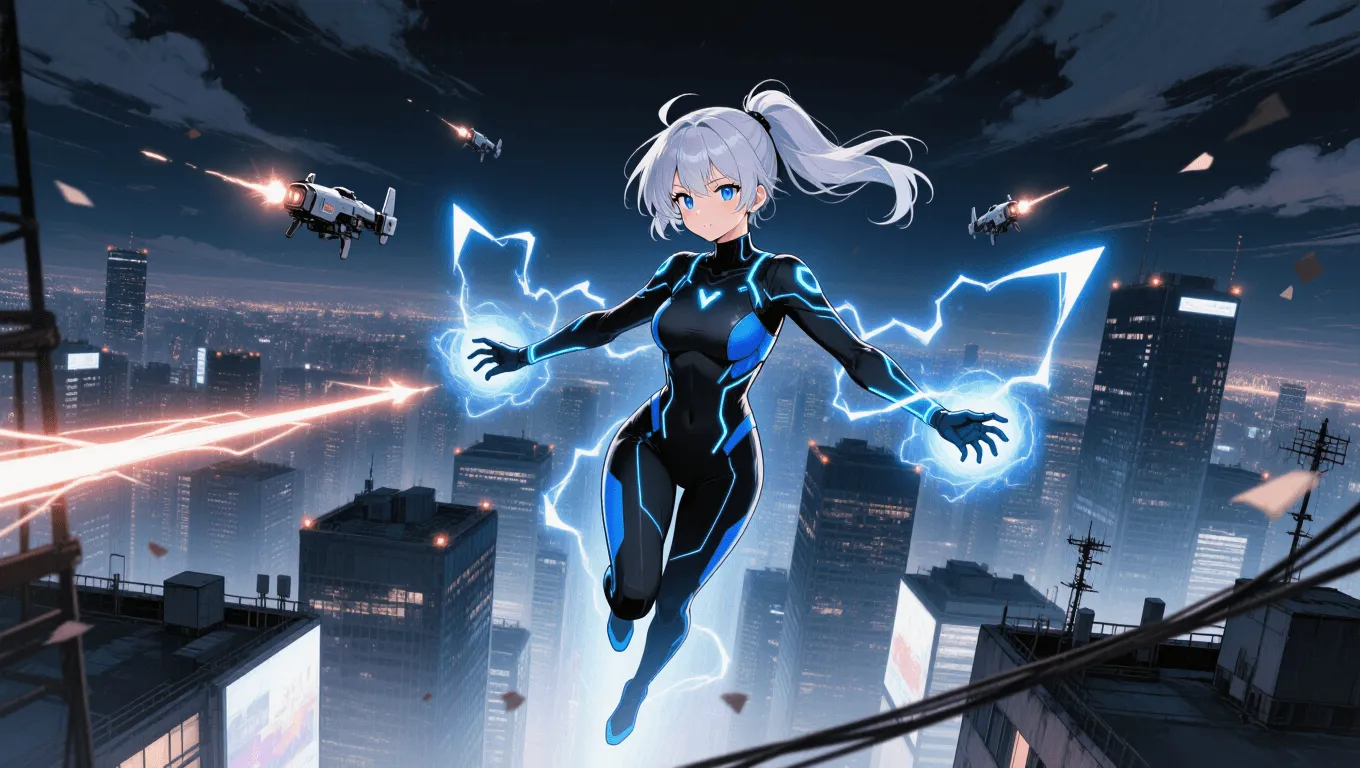Electrokinetic Flight

Electrokinetic Flight Video Demo 🎬
Table of Contents
- Electrokinetic Flight Video Demo 🎬
- What Is Electrokinetic Flight
- Core abilities of Electrokinetic Flight
- Application / Tactical Advantages in Combat
- Level: Level 1 🏙️, Level 2 🌇, Level 3 🌃
- Limitations of using the Electrokinetic Flight
- Weakness against what other superpowers
- Synergistic Power Combos
- Known Users
What Is Electrokinetic Flight
Electrokinetic Flight is the ability to achieve controlled aerial movement by generating, shaping, and riding electrical phenomena. Users manipulate electric fields, electromagnetic forces, and ionized air to lift off, hover, and maneuver. Unlike traditional levitation, Electrokinetic Flight relies on electrokinesis—electricity manipulation that can produce thrust, create magnetic lift, or form a stabilizing electric aura. In comics and games, this power appears as lightning-propelled dashes, EM-field gliding, and high-speed arcs between conductive points. For more abilities like this, explore the full list on the Superpower Wiki, or try your luck with our random superpower generator.
Core abilities of Electrokinetic Flight
Electrostatic Lift and Hovering
By building charge differentials between the body and the surrounding air or ground, the user produces a gentle repulsive force for low-altitude lift. This “electrostatic cushion” enables quiet takeoffs, sustained hovering, and millimeter-precise positioning ideal for stealth infiltration or reconnaissance.
Electromagnetic Propulsion (Lorentz Push)
Advanced users project strong magnetic fields and pulse them against nearby ferromagnetic structures—steel beams, vehicles, power lines—to generate momentum via the Lorentz force. This EM propulsion grants fast, agile travel in urban landscapes and industrial zones, functioning like magnetic parkour across the skyline.
Ionized Air Thrust (Plasma Jetting)
By superheating and ionizing air, the user can expel a high-velocity plasma flow behind or beneath them. While more energy-intensive than hovering, plasma jetting yields explosive acceleration, sharp vertical climbs, and emergency evasive bursts. The intense glow and crackle can also intimidate enemies.
Lightning Rail Hopping
“Rail hopping” is the signature mobility trick: the user chains movement along conductive paths, leaping from a power line to a neon sign to a grounded antenna. Each micro-jump is a controlled arc discharge; when chained at speed, it becomes a blur of lightning-propelled travel.
Electric Aura Stabilization
A self-generated electric aura acts as a dynamic stabilizer—countering crosswinds, dampening turbulence, and auto-correcting body pitch and yaw. The aura can double as a Faraday sheath, shedding small-arms fire or dispersing incoming micro-drones by overloading their circuits at close range.
Kinetic Braking & Soft Landings
By inverting field polarity and bleeding current through the air, users can convert forward momentum into heat and light, achieving controlled deceleration and feather-light landings. This “electrobrake” cuts impact injuries and enables pinpoint drop-offs.
Situational Recharging
Skilled fliers sip current from street grids, batteries, capacitors, or storm clouds while in motion. Passive recharge extends flight time, powers onboard gear, and keeps a reserve for shields or offensive bolts without touching down.
Application / Tactical Advantages in Combat
-
Rapid Verticality & Terrain Control: Jump floors, roofs, and ravines instantly; flank snipers, bypass chokepoints, and seize high ground.
-
Hit-and-Fade Strikes: Combine lightning dashes with short-range zaps for disruptive flybys; exit before counterfire locks on.
-
Aerial Crowd Control: Arc chains can stun clusters below; hovering enables non-lethal takedowns with precise amperage.
-
EM Disruption: Pulse fields to scramble drones, disable sensors, or force smart munitions into fail-safe.
-
High-Speed Recon: Silent electrostatic hover and high-angle vantage points enhance surveillance without rotor noise.
-
Environmental Leverage: Urban jungles rich in cables, rails, and steel magnify propulsion options; storm fronts provide abundant charge.
-
Extraction & Rescue: Zero-footprint insertions, building-to-building evacuations, and swift casualty relocation using soft-landing control.
Level: Level 1 🏙️, Level 2 🌇, Level 3 🌃
Level 1

Profile: Initiate of electrokinesis beginning to shape lift.
Feats:
-
Short-duration hovering (3–10 meters) and careful low-speed drifts.
-
Micro-dashes between close conductive points (power boxes, lamp posts).
-
Basic electrostatic cushioning for safe, low-height drops.
Risks: Overheating palms/soles from poorly managed discharge; visible sparking alerts enemies.
Training Focus: Breath-linked current modulation, posture for center-of-mass stability, and safe grounding techniques.
Level 2

Profile: Competent flier with mixed-mode propulsion.
Feats:
-
Sustained rooftop-to-rooftop travel; controlled climbs to tower heights.
-
Combined hover + arc-dash maneuvers; midair course correction under crosswind.
-
EM pulses to nudge or stall drones; emergency plasma burst for evasive escape.
Risks: Battery drain in low-conductivity zones; interference with team electronics; fatigue from repeated plasma jetting.
Training Focus: Efficient route planning using conductive “lightning rails,” field shaping for turbulence damping, and rules of engagement for EM use around allies.
Level 3

Profile: Master of electric and electromagnetic flight physics.
Feats:
-
City-crossing speed using rail hopping and Lorentz thrust.
-
Precision landings on moving vehicles; midair grapples and aerial takedowns.
-
Active Faraday sheath to shrug off small-arms near-misses and sensor locks.
-
In-storm recharging, riding natural lightning channels without losing control.
Risks: Collateral damage from high-amperage arcs; noticeable EM signature; weather amplification can escalate small errors.
Training Focus: Fine-grained current budgeting, combat air patrol tactics, and fail-safe shutdowns to avoid cascading overloads.
Limitations of using the Electrokinetic Flight
-
Energy Demand: Long-distance flight requires constant current; without recharge sources, endurance falls sharply.
-
Environmental Dependence: Open countryside offers few conductors for EM thrust; desert air’s low humidity can hinder stable arcs.
-
Insulation & Grounding: Rubberized or non-conductive environments reduce traction for “lightning rails.” Deep grounding (wet earth, grounded cages) can bleed off lift.
-
Weather Variability: Storms provide energy but also chaos—sudden gusts, unpredictable charge paths, and risk of uncontrolled lightning strikes.
-
Collateral EM Effects: Friendly electronics, medical devices, and tactical radios may glitch within the user’s aura.
-
Thermal Buildup: Plasma jetting generates heat; prolonged use can cause fatigue, dehydration, and gear failure.
-
Line-of-Sight Hazards: Overhead lines, antennas, and cranes present entanglement and arcing risks during high-speed maneuvers.
-
Signature Exposure: Bright arcs, ozone smell, and RF noise can reveal position unless the user employs low-visibility electrostatic modes.
Weakness against what other superpowers
-
Grounding & Insulation: Earth-based grounding, forcefields tuned to sink charge, or materials like rubber and ceramics reduce lift efficiency and arc chaining.
-
Power Nullification: Anti-energy auras, dampening fields, or ability blockers collapse electric and EM generation mid-flight.
-
Hydro/ Cryokinesis: Water manipulators can redirect current into harmless sinks; ice walls and sleet disrupt ionized-air thrust and increase stall risk.
-
Aerokinesis: Wind controllers can shear the electric aura, induce turbulence, or push plasma exhaust back onto the user.
-
Magnetokinesis (Hostile): Enemy EM shapers can counter-steer or pin the user by manipulating the very fields they rely on.
-
Vibration/ Sonics: Resonant vibrations can destabilize posture and field coherence, causing painful feedback or forced landings.
-
Shadow/ Darkness Manipulation: Visual occlusion and cold, still air complicate arc prediction and make rail hopping hazardous.
Synergistic Power Combos
-
Electrokinesis + Magnetokinesis: Classic pairing: powerful Lorentz thrust, magnetic braking, and precise midair grappling with metallic objects.
-
Electrokinesis + Technopathy: Real-time grid mapping, safe siphoning from power infrastructure, and in-flight drone escort.
-
Electrokinesis + Weather Manipulation: Self-made storm cells for recharging, lightning channeling for ultra-long leaps, and thunderclap shock tactics.
-
Electrokinesis + Metal Manipulation: Create “conductive runways” from floating metal shards; on-demand rails for silent, dynamic routes.
-
Electrokinesis + Telekinesis: Redundant lift and inertial dampening; TK stabilizes high-G turns while electricity provides thrust.
-
Electrokinesis + Photokinesis: Strobe camouflage, glare bursts to blind AA gunners, and light-bending around the electric aura to reduce signature.
-
Electrokinesis + Healing Factor: Mitigates thermal stress, nerve fatigue, and micro-burns from frequent plasma usage.
Known Users
-
Static (Virgil Hawkins) — Often depicted riding an electromagnetic disc, using city infrastructure to enhance mobility.
-
Magneto — Achieves flight via powerful electromagnetic manipulation and magnetic fields.
-
Livewire — A living conduit for electricity who can travel along power lines and through circuits.
-
Black Lightning — Electricity-based hero; some portrayals include limited levitation or boosted jumps using electric discharge.
-
Electro — Can ride power lines and perform electric-propelled movement; depictions vary across media.
Looking for more powers like this one? Visit our Superpower Wiki and spin the random superpower generator to discover new abilities.
